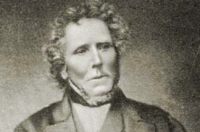










James Bowman Lindsay (8 September 1799 – 29 June 1862) was a Scottish inventor and author. He is credited with early developments in several fields, such as incandescent lighting and telegraphy.
Life and work
James Bowman Lindsay was born in Cotton of West Hills, Carmyllie near Arbroath in Angus, Scotland, son of John Lindsay, farm worker, and Elizabeth Bowman. During his childhood he was trained as a handloom weaver. However at the same time he educated himself and his parents recognised their son's potential. As a result they saved enough money to be able to send him to St. Andrews University where he matriculated in 1821.As a student he soon made a name for himself in the fields of mathematics and physics and, after completing an additional course of studies in theology, he finally returned to Dundee in 1829 as Science and Mathematics Lecturer at the Watt Institution.
Among his technological innovations, which were not developed until long after his death, are the incandescent light bulb, submarine telegraphy and arc welding. Unfortunately, his claims are not well documented but, in July 1835, Lindsay did demonstrate a constant electric lamp at a public meeting in Dundee, Scotland. He could "read a book at a distance of one and a half feet".However, he did little to establish his claim or to develop the device.
In 1854 Lindsay took out a patent for his system of wireless telegraphy through water. This was the culmination of many years' painstaking experimentation in various parts of the country. The device, however, had an unfortunate flaw. In order to maximise its effectiveness, it was desirable to lay another line on dry land, which exceeded the width of water to be traversed. Although this would have been possible across the Straits of Dover, it would not have been practicable in the case of the Atlantic. A realistic alternative the use of significantly larger batteries and terminals was never fully explored.
Aware the difficulties in laying transatlantic cable had not yet been solved, Lindsay took a great interest in the debate, with the revolutionary suggestion of using electric arc welding to join cables, and sacrificial anodes to prevent corrosion. These ideas, though not entirely new, were not to see widespread practical application for many years to come.
Lindsay was an accomplished astronomer and philologist. In 1858, he published a set of astronomical tables intended to assist in fixing historical dates, which he called his 'Chrono-Astrolabe'.The same year, on the recommendation of Prime Minister Lord Derby, Queen Victoria granted Lindsay a pension of £100 a year. He died on 29 June 1862.
Like Preston Watson, the Dundee pioneer of flight, Lindsay possessed neither the will nor the sheer ruthlessness to promote his innovations as effectively as he might. A deeply religious and humane person, he refused the offer of a post at the British Museum so that he could care for his aged mother.
Lindsay's chief glory lay in his vision, which helped to propel scientific advance through the 19th and 20th centuries. His Lecture on Electricity effectively foretold the development of the information society, and he confidently predicted cities lit by electricity. His concern with electric light was mainly prompted by the need to provide a safe method of illuminating the jute mills, where severe fires had devastated the lives of the workers.
James Lindsay was buried in the Western Cemetery, Dundee.In 1901 a monument, in the form of an obelisk, was erected by public subscription, at his grave.